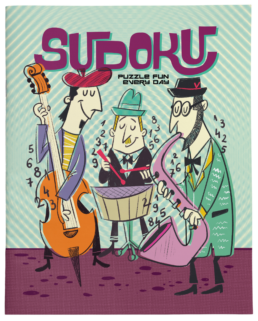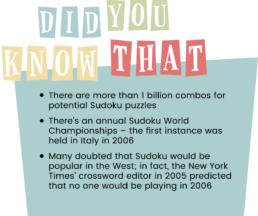Understanding Sudoku Puzzles
Learn More About the World’s Most Popular Numbers Game
When you see a grid, do find yourself tempted to fill it with digits 1 through 9? If so, you’re probably a sudoku fan – and you’re certainly not alone.
This centuries-old puzzle has captivated puzzle fanatics all over the world. How has it managed to stay so popular, and why does it have such a strong hold on puzzle fans? We’ll walk you through it all below.


What is Sudoku, and How Does It Work?
Sudoku is a type of puzzle that first emerged in French newspapers in the 19th century. The modern version of Sudoku that we play now was first published in Japan in the 1980s. ‘Sudoku’ is Japanese for ‘single number.’
Every game of sudoku begins with a 9×9 grid. A few digits will be filled in at the beginning of the game, and it is your goal to correctly fill in the remaining digits.
The placement of these digits seems simple, but it’s harder than it sounds: every line and ‘box’ (3×3 grid) must contain all digits, 1-9, with no repeats. That means every small square, every horizontal line, every vertical line and even every diagonal line must be complete with these digits.
You must use problem-solving strategies to figure out which digits go where. It’s a challenging puzzle – but there’s nothing more rewarding than seeing your puzzle complete

What is Sudoku, and How Does It Work?
Sudoku is a type of puzzle that first emerged in French newspapers in the 19th century. The modern version of Sudoku that we play now was first published in Japan in the 1980s. ‘Sudoku’ is Japanese for ‘single number.’
Every game of sudoku begins with a 9×9 grid. A few digits will be filled in at the beginning of the game, and it is your goal to correctly fill in the remaining digits.

The placement of these digits seems simple, but it’s harder than it sounds: every line and ‘box’ (3×3 grid) must contain all digits, 1-9, with no repeats. That means every small square, every horizontal line, every vertical line and even every diagonal line must be complete with these digits.
You must use problem-solving strategies to figure out which digits go where. It’s a challenging puzzle – but there’s nothing more rewarding than seeing your puzzle complete

How Sudoku Benefits Your Brain
Sudoku puzzles aren’t just fun – they also improve your brain health in plenty of ways, including:
Improves Concentration
Everyone struggles with keeping their attention span in check from time to time. Fortunately, playing Sudoku can sharpen your ability to focus.
The nature of the game requires you to use a small set of digits and a relatively simple grid. With so few distractions and straightforward problems to solve, the game trains your brain to focus only on the steps it actually needs to take.
Sharpens Memory
You may be surprised to learn that playing sudoku can increase the quality of your memory. The game challenges you to take quick mental notes and incorporate them into your moves. Your brain catches onto this process, and as a result, you will learn to juggle more info worth remembering outside of your puzzles.
Encourages Problem Solving
One of the best benefits of playing sudoku is that it trains you to develop sharp problem-solving skills. This is particularly true when you consider that many players choose to time themselves when they play. As a result, sudoku can improve your ability to find answers by taking the most effective route.
What’s the Secret to Solving Tough Sudoku Puzzles?
It’s so easy to get stuck in sudoku. Whether you’re having trouble filling in the final blanks, or struggling to figure out where to start, have no
fear – there are plenty of great strategies you can take to conquer any puzzle:
- Remember that ‘process of elimination’ is the name of the game. In sudoku, solving a square has more to do with what the result cannot be than what it is.
- Don’t forget about the two diagonal lines! Players often forget that these cannot share duplicate digits.
- Having trouble remembering things? Use the margins of the page to track reminders you can use later in the puzzle.
- You may also choose to take small notes within blank squares, and write potential options for those squares’ outcomes.
- Try scanning three rows or columns at a time. This way, you can scan your options more easily.
- Make sure your eyes aren’t playing tricks on you! Some digits look similar to each other (3 and 8, or 6 and 9, for example).
- Remember – practice makes perfect! The more you play, the sharper you’ll get.

What Makes W_RDPLAY Puzzles Different
Whether you’re a beginner sudoku player or a total puzzle freak, we know you’re chasing the greatest set of puzzles you can find. W_RDPLAY has exactly what you’re looking for.
We love puzzles, just like you, and we carefully determine which puzzles bring out the right level of fun and challenge to every player.
Not all sudoku puzzles are created equally, but we ensure that our puzzle books have a great selection of puzzles to keep you busy over the month – until the next issue arrives!
Never before has such a classic puzzle felt so fresh!
All of Our Puzzle Books Have These Features:
- Over 60 puzzles per book
- Brand-new, never-before seen titles
- High-quality bright white paper that’s perfect for your pen or pencil
- Canadian spelling used in our word puzzle books




